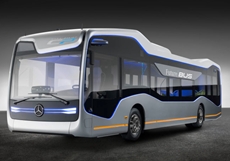Daimler unveils world’s first self-driving bus
20 Jul 2016
After bringing the world's first self-driving truck to public roads, luxury carmaker Mercedes-Benz and its parent company Daimler has now unveiled a self-driving bus.
 The Mercedes-Benz Future Bus with CityPilot in its debut drive covered a 20km route in Amsterdam, stopping at bus stops with centimetre accuracy. It responded autonomously to traffic lights, and hit speeds of up to 70km/h, avoiding pedestrians, following bends and negotiating tunnels.
The Mercedes-Benz Future Bus with CityPilot in its debut drive covered a 20km route in Amsterdam, stopping at bus stops with centimetre accuracy. It responded autonomously to traffic lights, and hit speeds of up to 70km/h, avoiding pedestrians, following bends and negotiating tunnels.
In May 2015, Daimler became the first company to get a license for road use in the state, for an autonomous truck - a massive futuristic, driverless truck, described as its Freightliner of the future (See: Daimler unveils self-driving 18-wheel truck) .
And, in June 2014, Daimler-owned Mercedes-Benz carried out a trial run of one of its high-tech autonomous trucks on a section of the A14 autobahn near Magdeburg, Germany (Mercedes-Benz tests high-tech self driven truck).
Dr Wolfgang Bernhard, member of the Board of Management of Daimler AG for Daimler Trucks & Buses said, "With our Highway Pilot, we showed nearly two years ago that autonomous driving will make long-distance truck transport safer and more efficient. We are now putting this technology into our city buses with CityPilot, " AFP Relax News reported.
Although there was a driver on board, the company's CityPilot technology, successfully completed the journey, communicating with sensors and markings integrated into a specially prepared bus lane, which, according to Daimler was the fastest, simplest and most cost effective way of adapting existing highway stretches for use by semi-autonomous vehicles.
Using connectivity and cameras, Mercedes' semi-automated city bus would provide a solution to traffic and environmental concerns even as it transformed the bus ride into a more comfortable experience.
The system can be put to use right away, because unlike connected cars, it can work with existing roads and infrastructure.
The Future Bus also uses a new approach to travelling, inside, splitting passengers on the basis of the length of their journey rather than grouping them in one zone for all. Passengers with longer journeys get better, less accessible seats, while those on shorter journeys may be closer to the exit. This would make the movement of passengers far more efficient.
According to commentators, autonomous technology might be great for cars, but it would really come into its own in the public-transport sector.





















